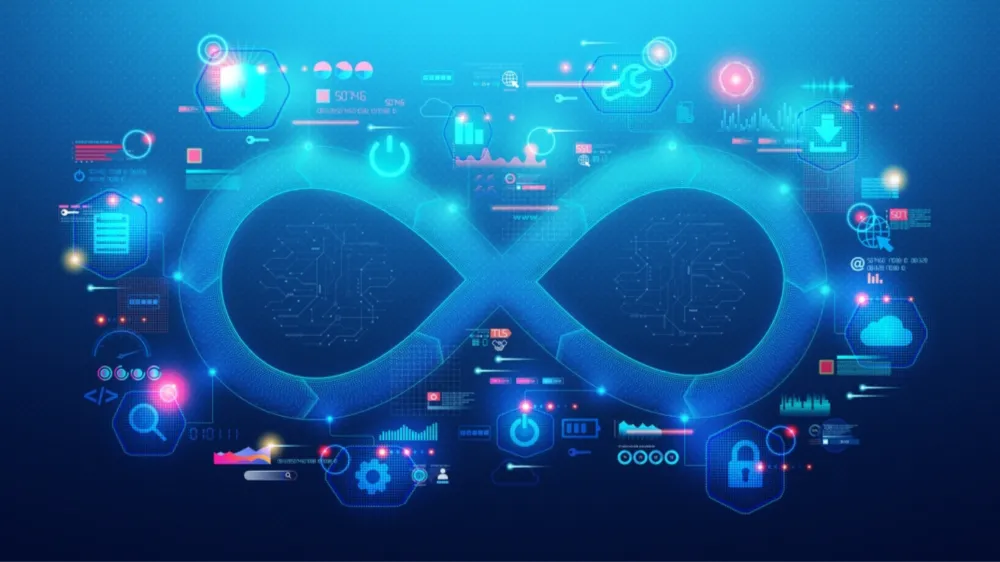Perforce Software states that 65% of managers, software developers, and executives have begun the implementation of continuous delivery throughout their healthcare organizations.
As these statistics show, continuous delivery in healthcare is familiar to experienced software developers. Industry leaders must avoid system breakdowns in healthcare at all costs since a single incident can risk patients’ health and the healthcare organization’s reputation. The importance of CD is evident in our field, where it facilitates fast failure detection and enhances testing efficiency through automation.
Let’s look at a comprehensive overview of the definition, benefits, and implementation approach to continuous delivery in healthcare.
What Is Continuous Delivery?
Continuous delivery is a modern software development method in which frequent code updates are pushed into a central repository. It allows various changes to be automated, then moved to non-production staging or testing, and prepared for release into production as early as possible without compromising quality. These changes can involve introducing new functionalities, adjusting configurations, resolving bugs, and conducting experiments.

Continuous delivery minimizes feedback loops to enhance software quality. It enables developers to quickly build, test, and deploy software through automation, APIs, and incremental updates instead of spending extensive time revamping significant sections of the product code.
How Does Continuous Delivery Work in Healthcare?
The continuous delivery pipeline goes through 4 phases: component, subsystem, system, and production.
Code reviews and tests verify components of the continuous delivery pipeline. Code reviews aid feature understanding, while unit tests ensure code quality. In this phase, static code analysis detects issues, including security vulnerabilities and potential memory leaks.
In the next stage, the loosely connected components form subsystems, the most minor deployable units. Subsystems undergo functional, performance, and security tests. While functional tests cover customer scenarios, performance tests set benchmarks integrated with pipelines. Security tests such as dynamic analysis security testing identify significant breaches and force the pipeline to abort.
After ensuring subsystems meet expectations, the pipeline assembles a system upon full release. Systems are certified with integration, performance, and security tests, prioritizing interfaces and network validation in the testing phase.
In the last step, a continuous delivery pipeline includes a manual gate that requires human intervention. The engineering team ensures a deliverable product after each sprint, and the business team decides on the release to customers.
The continuous delivery model accelerates the cycle time of a cloud healthcare application, promoting agility in healthcare. It aids in providing timely solutions and increases developers’ productivity thanks to automation, decreasing the testing and verification time required for each feature. Attaining agility empowers healthcare organizations to promptly address changing patient demands, regulatory mandates, and technological progress.
Are There Differences between Continuous Delivery and Continuous Deployment?
While sometimes misunderstood as the same, continuous delivery and continuous deployment are separate terms for automation implementation in healthcare software development. Here are some differences:
- How it works
- What problem it answers
- Level of automation
Unlike continuous deployment operations, continuous delivery automates the deployment of code changes in a staging or testing environment. Continuous deployment, conversely, encompasses automatically deploying a developer’s adjustments from the repository to production for customer use.

Regarding the main problem, continuous delivery tackles extended delays due to limited communication between IT engineering and business teams. On the other hand, continuous deployment helps address the issue of burdening operations teams with time-consuming manual tasks that impede application delivery.
In terms of automation level, continuous deployment is higher than continuous delivery. In continuous delivery, code can go through testing and other processes automatically to prepare for production deployment, but it does need manual approval from operations to launch. Continuous deployment, however, automatically rolls out production updates if the code meets set standards without additional manual approval.
You can differentiate continuous delivery and continuous deployment by operation principle and target issues, but the level of automation helps you easily distinguish and utilize them effectively.
What Are the Benefits of Continuous Delivery in Healthcare?
The rise of continuous delivery in healthcare has allowed health-related services to be delivered to large numbers of patients faster and more effectively, with:
- Increased flexibility
- Lower levels of burnout
- Faster time-to-market
- Better compliance and security
- Cost efficiency
- Continuous improvement

1. Increased Flexibility
Continuous delivery allows flexibility across different scales by automating testing, staging, and production environments while ensuring consistent performance and reliability. Developers can swiftly replace redundant clusters or nodes with improved code by using containers on advanced platforms.
They can also manage repositories and deployments for changing environments, making them proactive in addressing new arising demands. This practice helps boost flexibility in developing new products in an existing environment or vice versa.
2. Lower Levels of Burnout
With continuous delivery’s automated processes and instant feedback mechanisms, development, operations, and quality assurance teams can collaborate more efficiently. This culture of transparency and communication facilitates swift issue resolution and smoother project execution, preventing software engineer burnout in healthcare.
3. Faster Time-to-Market
Continuous delivery in healthcare focuses on frequent updates and releases of code in smaller increments, removing the need for integration, testing, and hardening phases in significant releases. By performing ongoing code integration and deployment to production post rigorous testing, the continuous delivery model ensures code readiness for release.
Moreover, a production environment mirroring end-user setups is crucial during deployment, allowing failures to be identified and fixed more quickly. Containerization, for example, efficiently tests code in a production environment, focusing solely on the impacted release area to minimize the effort and frequency of testing, speeding up the launch rate.
4. Better Compliance and Security
An effective continuous delivery pipeline includes automated validation and compliance checks to minimize non-compliance risks and potential legal issues. This ensures that the software meets regulatory requirements before being deployed.
Developers code with compliance requirements in mind to ensure that all change requests or bug corrections comply with security and compliance standards, creating a record of developers’ modifications. Continuous delivery’s automation features can also encompass security and compliance protocols, ensuring uniformity in meeting compliance standards.
5. Cost Efficiency
The continuous delivery model can adjust to meet demand, helping to save costs by removing fixed costs linked to larger release processes. CD enables cost-effective operation in smaller, more scalable batches.
In addition, automating the continuous delivery pipeline diminishes the likelihood of errors occurring in the numerous repetitive stages. This action also demands less developer time, allowing them to focus on product development. If errors are promptly identified, fewer code adjustments will be required later on.
6. Continuous Improvement
Implementing continuous delivery in healthcare boosts the team’s speed, accelerating feature releases and bug fixes. This facilitates prompt address to market shifts, security issues, customer demands, and cost constraints.
By using automation, companies can gather crucial data on their software’s performance and dependability. This data-focused method enables teams to define obstacles and develop procedures to boost innovation and effectiveness in software development.
Key Components of a Successful CD Pipeline in Healthcare
Here are four must-have components if you want to succeed in building a CD pipeline:
- Automated testing
- Continuous integration
- Automated deployment
- Continuous monitoring

1. Automated Testing
Automated testing is instrumental in achieving the goal of delivering new code releases as fast as possible to customers of continuous delivery. Developers need primarily to create and maintain comprehensive, reliable, and automated test suites that can identify actual failures and only approve the code ready for release.
Integrating testing frameworks can automate test execution and reporting by integrating testing frameworks. Employ cloud-based testing solutions to run tests simultaneously in multiple environments and adjust the scale as required. Automated testing guarantees quality by ensuring new commits do not introduce bugs, and the software is constantly deployment-ready.

2. Continuous Integration (CI)
During continuous integration, developers write code for a version control system, which is compiled into executables and deployable packages. With deployment instructions, the final package is ready for the next stage.
Moving to Continuous Delivery (CD) involves the operations team overseeing the deployment process. They employ automated scripts to perform deployment tasks, transferring the package to test environments for final validation. After the testing phase, the package is deployed to production for user access. This smooth process allows for regular, dependable releases and ongoing enhancements.
3. Automated Deployment
Healthcare software can be automatically released and deployed through continuous delivery in healthcare. Each approved change in your production pipeline is released to customers without human interference.
Continuous delivery streamlines the complete software release process. Each committed revision initiates an automated sequence that builds, tests, and prepares the update for deployment.
4. Continuous Monitoring
Continuous monitoring includes integrating feedback into the continuous delivery pipeline to control the status and performance of healthcare apps currently in operation. Developers can collect and showcase metrics on application performance, resource utilization, and user experience. This practice enables troubleshooting systems to investigate emerging properties and patterns interactively.
Other significant components of CD are automated alerts and notifications, helping inform individuals of any unforeseen incidents in production environments. In this case, developers leverage data analytics and user feedback to enhance software functionalities and determine development priorities.
Best Practices for Continuous Delivery in Healthcare
To implement continuous delivery in your healthcare business without fail, take these guides into thorough consideration:
- Early security integration
- Ongoing testing
- Effective data practices
- Tool selection autonomy

1. Early Security Integration
Security must be incorporated from scratch into the development and testing stages of the software creation process. The information security team should be involved in both application design and demonstration steps. Application security reviews may need pre-approved security libraries and security feature testing automation.
2. Ongoing Testing
Ongoing testing refers to continuous testing with minimal human involvement. Unlike the traditional waterfall method of testing at the end of a development cycle, it involves testing throughout the release process, starting when developers deliver code. The overarching goal is to detect bugs early, allowing testers to promptly flag them for developers before further development starts with flawed code.
During ongoing testing, developers and testers collaborate closely, minimizing the delay times and frequencies due to miscommunication. They can engage in test-driven development, receive test feedback within ten minutes, and consistently enhance their test suites to enhance defect detection and manage complexity effectively.
3. Effective Data Practices
Good practices involve having sufficient data to run your test suite and ensuring that the data does not restrict the number of tests you can conduct. Your teams should reduce the test data volume necessary for executing automated tests.
Development teams are advised to make database modifications adhering to essential practices. This includes storing database adjustments as scripts in version control and handling them as production application changes. That way, database changes in the software delivery process are clarified.
4. Tool Selection Autonomy
Teams should choose their tools for continuous delivery in healthcare, and specialists should decide which resources are needed for optimal performance. They must ensure the correct utilization of continuous delivery methods and technologies by evaluating scalability, integration, compliance, and user-friendliness before making a decision. Additionally, developers can consider adopting containerization platforms to enhance the efficiency of deploying and managing healthcare applications.
Partner with KMS Healthcare to Develop Exceptional Healthcare Software
When implementing continuous delivery, it is essential to avoid being confused by other relevant terms, such as continuous integration or continuous deployment. It is also a must to understand the primary components of a well-oiled CD pipeline and learn how to customize approaches from suggested practices for the fullest utilization.
By collaborating with KMS Healthcare, you can access a versatile pool of tech specialists, from developers and testers to Scrum masters and automation testing engineers. KMS Healthcare gives industry leaders access to expert comprehension and extensive experience in automation-centric product development.
KMSH software development services are on hand to assist in boosting development teams like yours with a customer-driven mindset and professional working ethics. Together with KMS Healthcare, you’ll be on the cutting edge of crafting and developing software solutions for the medical industry.
